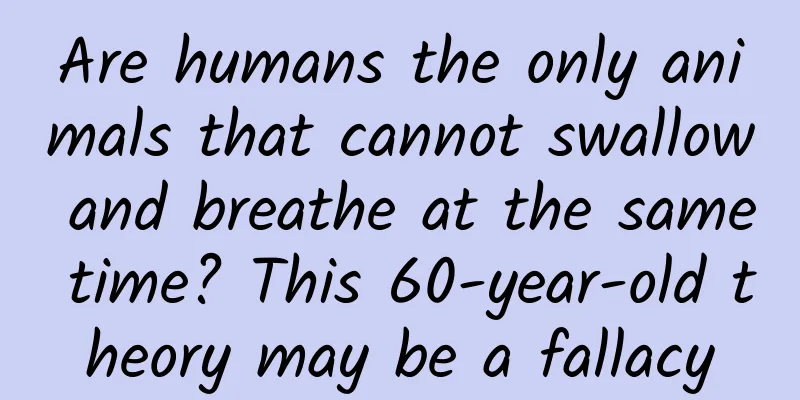Are humans the only animals that cannot swallow and breathe at the same time? This 60-year-old theory may be a fallacy

|
The assertion that "humans lost the ability to breathe while swallowing due to the evolution of language" is based on extremely one-sided research and limited and flawed evidence, but it has been widely circulated, which highlights the difficulty of distinguishing true and false information in the Internet age. Written by Li Changqing (Doctor of Medicine, practicing physician in the United States) Several years ago, I visited the Museum of Natural History in Washington, and saw an interesting piece of knowledge in the exhibition hall about human evolution. The general content was that during the evolution of human language, the structure of the larynx and mouth changed, which allowed humans to have richer language, but also made them more prone to respiratory aspiration of food - and humans are the only animals that cannot swallow and breathe at the same time. Later, the author read from other popular science articles that the loss of this ability is not innate. When babies are born, they still have the ability to swallow and breathe at the same time. Later, as they develop, this ability disappears. We were taught from a young age not to talk or laugh while eating, and to be careful not to choke. Later, as a gastroenterologist, I discovered that when performing a gastroscopy on a patient, letting the patient keep breathing could inhibit swallowing and vomiting. This understanding also reinforced the above cognition. Last month, Nature published a study on the mechanism by which the tails of humans and other primates became shorter and disappeared during evolution, which made me interested in the conclusion that the ability to swallow and breathe simultaneously was lost due to the evolution of language. I wanted to write something about this issue. However, after searching a series of studies, I changed my mind. The main discoverers and promoters of the above theory are a pair of anatomical masters and apprentices, one is the late Yale University anatomy professor Edmund Crelin, and the other is his student, anatomy professor Jeffery Laitman, who works at Mount Sinai School of Medicine in New York. The two professors have many theoretical works in anatomy and anthropology, one of which is the study of the anatomical structure of the human throat. According to their discussion, the biggest difference between the structure and function of the human throat and that of other animals is the location of the epiglottis. The epiglottis is a soft tissue in the throat, located above the tracheal opening, which can temporarily close the trachea when swallowing, thus separating the esophagus and trachea. It will also temporarily close when burping, thus producing a distinctive burping sound. Crelin and Laitman's theory holds that during the evolution of humans' complex language function, the position of the human epiglottis was lowered below the larynx, so the position of the tracheal opening was low, which was prone to aspiration, and the ability to close the trachea when swallowing to prevent aspiration needed to be evolved. In other animals, including non-human primates, the epiglottis is higher and connected to the soft palate, allowing food and fluids from the mouth to bypass the tracheal entrance and enter the esophagus from both sides of the epiglottis, but at the same time maintaining continuous patency of the nasal cavity and trachea, so that breathing can be maintained while swallowing. The epiglottis of human infants is still relatively high, and they can suck and swallow at the same time; as they age, the epiglottis is lowered, forming the same reflex as adults, and thus losing the ability to breathe while swallowing. Their theory was widely spread, with many web pages repeating the same content. It was also accepted by important science institutions such as the Museum of Natural History in Washington, which shows that it had a great influence. But is this really the case? The biggest critic of this theory comes from Professor Joel Vilensky of Huntington University in Indiana, whose majors include anatomy and cell biology. His criticism of Crelin and Laitman is mainly aimed at the anatomical structure of children's throats. There are two main points: First, the observation that the epiglottis is higher in infants is probably a normal variation that is not sufficient to cause functional differences. The autopsy of infant corpses found that some infants had higher epiglottis and some had lower epiglottis, but there was no obvious difference in physiological function. Crelin and Laitman probably only selected the higher epiglottis variation to report. Second, and most importantly, Crelin and Laitman's assertions have never been confirmed by lactation researchers and speech therapists. In the view of these professionals engaged in breastfeeding research, infants should close their glottis and hold their breath while swallowing, just like adults do when they eat. Evidence for this comes not only from clinical observations, but also from imaging studies. However, Crelin and Laitman turned a deaf ear to these contrary evidences. Crelin and Laitman's statement is also inconsistent with what many people have seen in practice. According to their theory, humans are the only animals that cannot swallow and breathe at the same time, and are also the animals most likely to aspirate food. However, professionals in the veterinary field have found that any higher animal may aspirate, including most birds and mammals. People who keep pets often see their cats and dogs choking because they eat too quickly. The exceptions are special mammals such as dolphins and whales. Their respiratory tracts open on the top of their heads, and they mostly eat underwater. They do not breathe at the same time, so aspiration is basically not a possibility. There is another statement that is obviously not in line with common sense, that is, except for humans, other animals rarely breathe through the mouth. But many people who have raised dogs know that this is not true. In addition, some people have done experiments and found that after artificially causing nasal congestion in monkeys, they will quickly switch to breathing through the mouth. Obviously, breathing through the mouth is not exclusive to humans. In response to this question, Vilensky pointed out that although Crelin and Laitman's theory was widely spread in the past and was proposed very early (in the 1960s), it was only spread in a small circle and had limited influence. After all, few people specifically read paper anatomical works. However, with the rise of the Internet, the influence of this theory began to emerge. If a new mother searches online for questions about infant feeding and breathing, she will likely find information that "infants can breathe and swallow at the same time." If she finds that her baby needs to stop and breathe while feeding, she will think that the baby's nasal cavity is blocked or there is a problem with feeding, which will cause unnecessary psychological burden and unnecessary consultation and help. Some may even give up breastfeeding and switch to bottle feeding. According to Vilensky, such cases happen from time to time. If you are a medical school graduate or a professional working in pediatric nursing, you may also be troubled by the relevant news. According to Vilensky, similar situations have already occurred. If I hadn’t written this article specifically to search for opinions from both sides, I might have kept my previous misconception that humans are the only animals that cannot swallow and breathe at the same time, and only babies can breathe and feed at the same time. I have shared this understanding with others before, and those who heard it might continue to believe it. In this sense, the Internet has increased the amount of information, but it has also increased the difficulty of information screening. Especially for some controversial topics within the profession, it is even more difficult to screen. Improving critical thinking ability is a long and arduous task. Reference Links [1] https://www.si.edu/newsdesk/factsheets/did-you-know-human-origins-facts [2] https://dentalsleeppractice.com/ce-articles/evolution-human-oral-airway-apnea/#:~:text=Figure%2010%3A%20Chimpanzee%20demonstrates%20the,demonstrating%20a%20non%2Dintranarial%20airway [3] https://www.researchgate.net/publication/355186118_Infants_can_breathe_and_swallow_at_the_same_time [4] https://www.researchgate.net/publication/353847247_Newborn_Anatomy [5] https://www.semanticscholar.org/paper/Primate-experiments-on-oral-respiration.-Harvold-Tomer/92bb372e8216f6c17533e2cdddfb6f4850926323 This article is supported by the Science Popularization China Starry Sky Project Produced by: China Association for Science and Technology Department of Science Popularization Producer: China Science and Technology Press Co., Ltd., Beijing Zhongke Xinghe Culture Media Co., Ltd. Special Tips 1. Go to the "Featured Column" at the bottom of the menu of the "Fanpu" WeChat public account to read a series of popular science articles on different topics. 2. Fanpu provides a function to search articles by month. Follow the official account and reply with the four-digit year + month, such as "1903", to get the article index for March 2019, and so on. Copyright statement: Personal forwarding is welcome. Any form of media or organization is not allowed to reprint or excerpt without authorization. For reprint authorization, please contact the backstage of the "Fanpu" WeChat public account. |
Recommend
Overseas Promotion: How to promote and attract fans on YouTube?
Because of my work, I currently have the opportun...
Domestic mobile phones are quietly experiencing a price increase. Will consumers pay for them?
After smartphones entered the period of stock rep...
You can’t get it even if you pay 9,000 more! How long will Dongfeng Honda’s new Civic remain popular?
Dongfeng Honda, which has had mediocre sales in re...
Is it more useful to say sweet words to the left ear?
This article was reviewed by Zhao Wei, MD, associ...
Do you drool a liter of saliva every day? Uncover the mysterious story behind saliva
Have you ever wondered how the saliva that is pro...
iPad Pro or MacBook? If you are undecided, please read this
The launch of Apple's iPad Pro has sparked a ...
No chicken can leave Guangdong alive, and no fruit in Beijing is not made into dried fruit.
It is said that "after Laba Festival it is t...
O2O transforms traditional service industry in many ways, taking hairdressing as an example
The hairdressing industry is a basic need for mos...
The difference between VR and AR technology: application differences lead to two different concepts
Regarding virtual reality (VR) and augmented real...
50 Children's Day copywriting sentences, worth collecting!
I have shared the copy for Children’s Day before....
Will programmers be fired when they get older?
Internet companies like BAT may not recruit progr...
Collect! Enjoy the flowers and eat the fruits at the same time, these fruit trees can also be planted on the balcony →
Auditing expert: Yang Yanhui, Senior Garden Engin...
Selling hardware is just the beginning of "Internet + marketing"
As a winner of Toutiao's Qingyun Plan and Bai...
Nokia's comeback is not impossible
Nokia recently released its third quarter financi...
my country's first independently designed nuclear power plant has been generating electricity safely for 30 years
"Independent innovation is the soul of the d...









